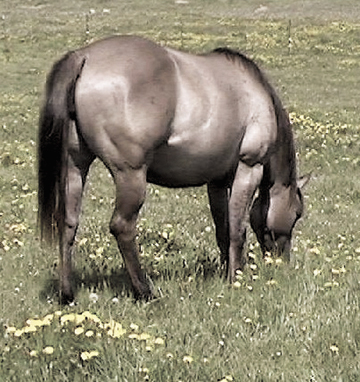|
Breeding For The Dilute Colors: GRULLA
Grulla is one of the hardest colors to get "accidentally". The easiest way to get a grulla foal is simply to breed a grulla to a grulla. This usually results in a grulla foal at least 75% of the time. The reason being that this color, like its close relative black, is a result of mostly a collection of "recessive" genes.Grulla is a ‘black based" color which means that the horses points (mane, tail and lower legs) are black. This group of colors includes bay, brown, black, dun, grulla, and genetically - perlino.The major genetic difference between grulla and buckskin are the ‘modifying’ genes present. All of the "black based" colors would be genotype ‘EE’ or ‘Ee’ which would be DOMINANT to the ‘ee’ genotype. The ‘ee’ genotype would produce "chestnut/sorrel based" colors. Colors in this group would include chestnut, sorrel, palomino, ‘dunalino’, red dun, and cremello. A few years ago the function of the ‘B’ gene was moved to the ‘E’ loci by geneticists but it’s original function has not changed.
This pretty grulla mare vividly displays the true grulla coloring. Various shades of grulla may be lighter or a few shades darker and exhibit more or less dun factor. This mare belongs to Kristy Enloe, Long Prairie, Minnesota. All three of the stallions used in this months charts are simple grullas - - not grullas with two dilution genes (on different loci). All data is taken exclusively from AQHA get records. Mare colors are also from the AQHA records department. Because of the expected percentage foals which are registered the wrong colors, for any number of reasons, it would be optimistic to expect 90% accuracy in the table below. Yet, as you can probably see, the results show definite trends that fit right in with what we should expect form these various crosses genetically.The results in this table could be reversed if you had a grulla mare and wanted to check on the results of breeding her to a bay, sorrel, etc. colored stallion. It is also important to note that there is now a test for homozygosity of the E gene. This inexpensive test will let a breeder know if his stallion or mare will produce 100% "black-based" colors
|


